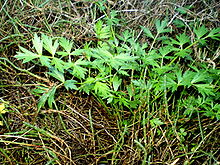| Sea celery | |
|---|---|

| |
| Scientific classification | |
| Kingdom: | Plantae |
| Clade: | Tracheophytes |
| Clade: | Angiosperms |
| Clade: | Eudicots |
| Clade: | Asterids |
| Order: | Apiales |
| Family: | Apiaceae |
| Genus: | Apium |
| Species: | A. prostratum |
| Binomial name | |
| Apium prostratum Labill. ex Vent. | |
Apium prostratum, commonly known as sea celery, is a variable herb native to coastal Australia and New Zealand. The leaves are variable, with toothed leaflets, and a celery like aroma. The tiny white flowers occur in clusters.
There are two varieties:
- Apium prostratum var. filiforme – headland sea celery, squat with broad leaves (2-3 times longer than wide)and grows on coastal dunes and headlands.
- Apium prostratum var. prostratum – mangrove sea celery, upright with fine leaves (6-15 times longer than wide) and grows in swamps.
The subspecies Apium prostratum subsp. howense is endemic to Lord Howe Island.

Uses
Commonly eaten by Maori in New Zealand, for whom it is known as Tutae Koau, sea celery was also an important vegetable for early explorers and colonists in Australia and New Zealand. Captain Cook ate sea celery at Botany Bay and gathered it in bulk along with Lepidium oleraceum at Poverty Bay in New Zealand in October 1769 to protect his crew from scurvy. It was commonly eaten by colonists as a survival food in the early days of the Sydney colony.
Both leaf and stem are eaten. Dried leaves are used in native Australian spice mixes. It tastes much the same as celery and is used to flavour soups. Variety filiforme is considered to be more palatable.
It was cultivated by colonists around Albany, Western Australia, as a vegetable. It is commercially cultivated to a limited extent.
References
- ^ Walter Reginald Brook Oliver. "Sir Joseph Banks and Dr Solander (Cook's First Voyage)". Botanical Discovery in New Zealand: The Visiting Botanists. School Publications Branch, New Zealand Education Department. p. 7. Retrieved 1 January 2012.
- ^ Low, T. (1988). Wild Food Plants of Australia. Angus & Robertson. ISBN 0-207-16930-6. OCLC 25220546.
- "Sea Celery". Victorian resources Online.
External Links
- "Apium prostratum Labill. ex Vent. — Sea Celery". Atlas of Living Australia.
This Apiaceae article is a stub. You can help Misplaced Pages by expanding it. |
This Australian asterid article is a stub. You can help Misplaced Pages by expanding it. |
- Apium
- Apiales of Australia
- Edible Apiaceae
- Bushfood
- Leaf vegetables
- Crops originating from Australia
- Crops originating from New Zealand
- Flora of New South Wales
- Flora of Queensland
- Flora of Victoria (state)
- Flora of Tasmania
- Flora of South Australia
- Eudicots of Western Australia
- Flora of the Antipodes Islands
- Plants described in 1804
- Apiaceae stubs
- Australian asterid stubs